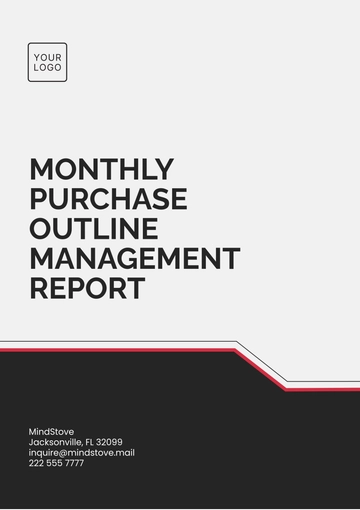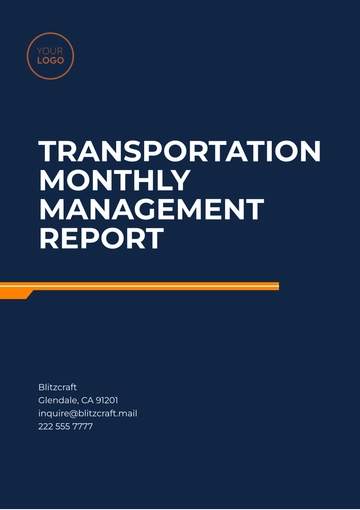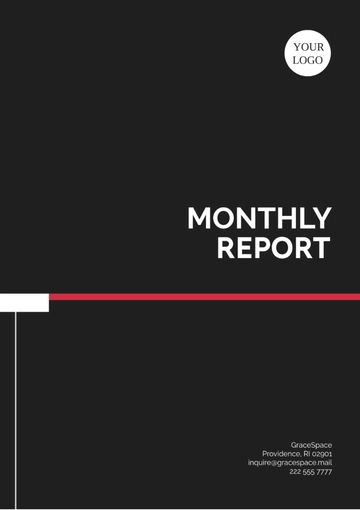Free Bookkeeping Monthly Report

I. Executive Summary
The monthly bookkeeping report for [Your Company Name] offers a comprehensive overview of our financial activities and current status. This report is designed to provide stakeholders with critical insights into the organization’s fiscal health. By analyzing income, expenses, and cash flow, we aim to highlight key trends and performance metrics that impact overall financial stability. This month’s analysis reveals patterns that can inform better financial decision-making, helping to align our operational activities with strategic goals.
In addition to detailed financial summaries, this report also identifies areas that may require adjustments or further investigation. Understanding these nuances will enable stakeholders to make informed choices about resource allocation, budgeting, and investment opportunities. By comparing month-over-month performance, we can track our progress toward achieving financial objectives while ensuring compliance with US laws and accounting standards. The insights provided here serve not only as a reflection of our financial standing but also as a tool for proactive management, ensuring that [Your Company Name] continues to operate efficiently and effectively in an ever-changing business environment. This month’s findings will guide future strategies and initiatives, contributing to our long-term success.
II. Financial Summary
1. Income Analysis
This section details the total income received during the month, categorized by various income streams. It highlights trends and identifies any significant variances from the previous reporting period.
Income Stream | Amount ($) | Percentage of Total Income |
|---|---|---|
Product Sales | 50,000 | 65% |
Service Revenue | 20,000 | 26% |
Other Income | 7,000 | 9% |
2. Expense Analysis
This part of the report breaks down expenses into categories to facilitate budget management and identify cost-saving opportunities. It compares current month expenses to those of previous months.
Expense Category | Amount ($) | Status |
|---|---|---|
Employee Salaries | 30,000 | Consistent |
Office Supplies | 2,000 | Increased |
Marketing | 5,000 | Decreased |
3. Cash Flow Statement
The cash flow statement provides insights into the cash inflows and outflows during the month. Understanding cash flow helps in planning for future financial needs and ensuring liquidity.
Total Cash Inflow: | $75,000 |
Total Cash Outflow: | $60,000 |
Net Cash Flow: | $15,000 |
III. Variance Analysis
1. Budget vs Actuals
Variance analysis involves the comparison of budgeted figures with actual results to understand performance discrepancies. This section provides a thorough review of key variances and their implications on the budget.
Description | Budgeted ($) | Actual ($) | Variance ($) |
|---|---|---|---|
Revenue | 70,000 | 77,000 | 7,000 |
Operational Costs | 50,000 | 52,000 | 2,000 |
Profit | 20,000 | 25,000 | 5,000 |
2. Performance Insights
This subsection explores the variances identified, discussing potential causes and suggesting corrective actions where necessary. Performance insights are essential for strategic adjustments to align with financial goals.
IV. Recommendations
Based on the analysis, several recommendations are proposed to enhance financial performance:
Refine marketing strategies to improve return on investment.
Implement tighter controls on office supplies to minimize costs.
Consider revising the budget to accommodate extraordinary variances.
V. Conclusion
This monthly bookkeeping report underscores the critical importance of consistent financial tracking and strategic planning for [Your Company Name]. Regular monitoring of our financial activities not only provides valuable insights into our current performance but also helps identify areas for improvement. By implementing the recommendations outlined in this report, the organization can optimize its financial health, enhance operational efficiency, and mitigate potential risks.
Taking proactive steps based on these findings will enable [Your Company Name] to adapt to market fluctuations and capitalize on emerging opportunities. Ultimately, a disciplined approach to bookkeeping and financial management will support sustainable growth, ensuring that we remain resilient and competitive in the dynamic business landscape. The commitment to these practices is essential for our long-term success.
- 100% Customizable, free editor
- Access 1 Million+ Templates, photo’s & graphics
- Download or share as a template
- Click and replace photos, graphics, text, backgrounds
- Resize, crop, AI write & more
- Access advanced editor
Simplify your financial reporting with the Bookkeeping Monthly Report Template from Template.net. This editable and customizable document provides a structured format for summarizing monthly financial activities, including income, expenses, and key financial metrics. Fully editable in our Ai Editor Tool, it allows you to tailor the report to your specific bookkeeping needs, ensuring accurate insights into your business's financial performance for effective decision-making.
You may also like
- Sales Report
- Daily Report
- Project Report
- Business Report
- Weekly Report
- Incident Report
- Annual Report
- Report Layout
- Report Design
- Progress Report
- Marketing Report
- Company Report
- Monthly Report
- Audit Report
- Status Report
- School Report
- Reports Hr
- Management Report
- Project Status Report
- Handover Report
- Health And Safety Report
- Restaurant Report
- Construction Report
- Research Report
- Evaluation Report
- Investigation Report
- Employee Report
- Advertising Report
- Weekly Status Report
- Project Management Report
- Finance Report
- Service Report
- Technical Report
- Meeting Report
- Quarterly Report
- Inspection Report
- Medical Report
- Test Report
- Summary Report
- Inventory Report
- Valuation Report
- Operations Report
- Payroll Report
- Training Report
- Job Report
- Case Report
- Performance Report
- Board Report
- Internal Audit Report
- Student Report
- Monthly Management Report
- Small Business Report
- Accident Report
- Call Center Report
- Activity Report
- IT and Software Report
- Internship Report
- Visit Report
- Product Report
- Book Report
- Property Report
- Recruitment Report
- University Report
- Event Report
- SEO Report
- Conference Report
- Narrative Report
- Nursing Home Report
- Preschool Report
- Call Report
- Customer Report
- Employee Incident Report
- Accomplishment Report
- Social Media Report
- Work From Home Report
- Security Report
- Damage Report
- Quality Report
- Internal Report
- Nurse Report
- Real Estate Report
- Hotel Report
- Equipment Report
- Credit Report
- Field Report
- Non Profit Report
- Maintenance Report
- News Report
- Survey Report
- Executive Report
- Law Firm Report
- Advertising Agency Report
- Interior Design Report
- Travel Agency Report
- Stock Report
- Salon Report
- Bug Report
- Workplace Report
- Action Report
- Investor Report
- Cleaning Services Report
- Consulting Report
- Freelancer Report
- Site Visit Report
- Trip Report
- Classroom Observation Report
- Vehicle Report
- Final Report
- Software Report





























